When people ask me “do Strats have a compound radius?” they are usually referring to any guitar that has a Strat-shaped body, not just a Fender instrument. The truth is that there are more “non-Fender” Strat guitars available with a compound radius neck, but some Fender Strats have them, too.
Keep on reading to learn more about what makes a neck radius “compound” and my favorite Strat-body guitars that have them.
You can use the table of contents below to take you to the area that interests you. Click on the little box to open it and then click on the section of the article you want to read, or you can read from start to finish if you want the full compound radius neck experience!
The Short Answer
Yes, some Fender Stratocasters are available with compound radius fingerboards. However, there are also a variety of “non-Fender” guitars with Strat-shaped bodies and a compound radius. Any of these guitars can make it easier and more comfortable to play chords near the nut and lead sounds near the opposite end of the neck.
Keep On Reading (Below) To Learn More
So, What Does Compound Radius Mean?
First, you need to understand how fingerboard radius (also called fretboard radius) is measured and why it matters.
Here is an image that illustrates the principle, comparing a 9.5 to a 12-inch fingerboard radius neck.
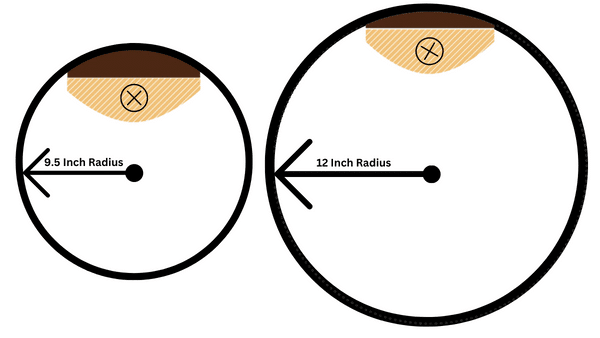
As you can see, the amount of each fingerboard curvature is determined by the circumference of that circle’s radius, where the mid-point is lined up to the center of the neck. That’s really all there is to it!
So, the bigger the fingerboard radius, the flatter the fingerboard, and vice-versa!
Therefore, the 9.5-inch fingerboard radius would be more curved than the 12-inch fingerboard illustrated above.
Now that we’ve gotten that out of the way, we can get on to the practical stuff!
What Makes A Compound Radius Neck Different?
Here is a diagram that shows the difference between a regular (straight radius) fingerboard and a compound radius fingerboard.
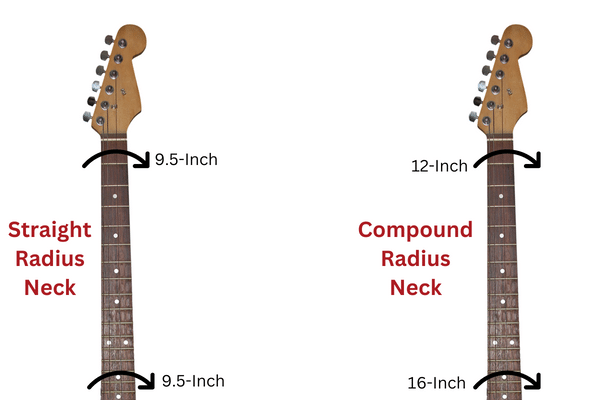
As you can see, a straight radius fingerboard has the same curvature all over the neck.
A “compound” radius neck fingerboard starts off more curved at the nut and progressively flattens out all the way down to the other end. This design can give you the best of both worlds.
The smaller radius areas of a compound neck make chord playing more comfortable, while the larger radius areas make it easier to bend strings.
Compound radius necks are great for guitarists that play rhythm and lead guitar. The downside is that they make the guitar more expensive. However, once you play one, you will probably want to take that baby home!
So, if you’re the lead guitar player in a high-octane Rock or Metal band, you should probably go with a 12-inch or larger straight radius neck or look into the compound radius option.
Is A Compound Radius Fingerboard Better?
Most electric guitar payers tend to think so, me included! The thing about a compound radius is that it feels so comfortable in the hand and is so versatile. That’s not to say that all the other guitar neck fingerboard radiuses can be replaced by it; they all have their uses and will each make you play a little differently!
However, I really do like struggling a bit with a guitar neck from time to time. It’s sort of like driving an old sports car with a standard shift and no power steering or power breaks, compared to driving a modern luxury car. The sports car is harder to drive but a lot more fun to take out on a winding road. The luxury car practically drives itself, but where’s the fun in that?
So, it’s all in the “eye of the beholder” or the “hand of the player,” so to speak. It’s ultimately up to you to decide!
Pros And Cons Of A Compound Radius Neck
Here are some things you should consider when thinking about getting a Strat with a compound radius neck. There’s not much on the cons side of the equation except for the additional cost.
While some players I know had a little difficulty adjusting their playing to a compound radius, the first neck I tried immediately felt very comfortable and natural. At this point, I have several guitars with compound necks and love playing all of them!


| Comparison | Pros | Cons |
|---|---|---|
| Chords | Easier to play chords | Can take awhile to adjust to |
| Single Notes | Easier to bend strings | Can take awhile to adjust to |
| Action | Generally lower all over the neck | None |
| Tuning | May be more stable | None |
| Intonation | Possibly more accurate | None |
| Cost | Worthwhile for pro players | Prohibitive for beginning players |
My Favorite Fender Compound Radius Strats
As guitars with compound radius necks become more and more popular, Fender has begun to offer them in select models.
Currently, the Fender Mod Shop does not offer a compound radius fingerboard option.
You can always have a master-built Strat with a compound radius neck made to your specifications at the Fender Custom Shop if you have the cash!
Here are three of my favorite off-the-shelf models.
Fender American Ultra Luxe Stratocaster
This is my number one favorite Strat with a compound radius neck! From the moment I played one, I just had to buy it! It plays like a dream and sounds fantastic!
The “Luxe” model comes with all the features of the American Ultra (see below), but it also has a painted headstock and stainless steel frets! The frets were a must-have for me. They make it super-easy to bend strings without creating friction (gawling) against the frets, especially when doing finger vibrato!

Click HERE To Check Price And Reviews On Amazon
Other Features (common to both the Ultra “Luxe” and Ultra models):
- 10–14-inch compound radius fingerboard
- Rounded fingerboard edges
- Augmented “D” neck profile
- Ultra Satin neck finish
- Ultra Noiseless pickups
- S-1 switch adds neck-position tones to positions 1 and 2
- Tip-less 2-point synchronized tremolo
Fender American Ultra Stratocaster
This guitar is the same as the Ultra “Luxe” Strat (see above), except it has nickel frets and doesn’t have the painted headstock.
I played both the Ultra and Ultra “Luxe,” and the Ultra model does not disappoint! If you like the feel of nickel frets, then this is the model for you.

Click HERE To Check Price And Reviews On Amazon
Features:
- 10–14-inch compound radius fingerboard
- Rounded fingerboard edges
- Augmented “D” neck profile
- Ultra Satin neck finish
- Ultra Noiseless pickups
- S-1 switch adds neck-position tones to positions 1 and 2
- Tip-less 2-point synchronized tremolo
Fender Dave Murray Stratocaster
If you love the sound of Iron Maiden, you should take a serious look at this Start! It is Dave Murray’s updated model.
I adore the Seymour Duncan pickup set and have used Hot Rails and the JB Jr in several guitar builds!
Take it from me; it’s all you need to drive any amp into the red zone!

Click HERE To Check Price And Reviews On Amazon
Features:
- 9.5″-14″ compound radius fingerboard
- C-shaped maple neck
- Seymour Duncan humbuckers (Hot Rails and a JB Jr in the middle)
- 2-point locking Floyd Rose tremolo
My Picks For Other Compound Radius Strats
You don’t necessarily have to go with a Fender guitar to get an instrument with a Strat-shaped body and a compound radius neck.
There are a variety of companies to choose from including:
- Jackson
- Charvel
- Ibanez
- ESP
- Schecter
- Boss
- Cort
- Suhr
- EVH
Here are some of the compound Strats that I think deserve special attention.
EVH Striped Series Frankenstein Relic
Everybody that is a serious Rock player is familiar with the late great Eddie Van Halen and the “FrankenStrat” he built to help get his sound.
Although the original Franenstrat had a “Boogie Body” neck and body (from Wayne Charvel) with modifications he made to the pickups and electronics, EVH now offers an excellent reliced facsimile of the instrument with a compound radius neck. Technically, EVH is owned by Fender musical instruments.
The Frankenstrat plays great and has Eddie’s sound in it. The humbucker pickup on this guitar and the EVH Wolfgang models were designed in close collaboration with Eddie himself! The neck pickup is for show only. I always have a difficult time putting this guitar down!

Click HERE To Check Price And Reviews On Amazon
Features:
- 12″-16″ compound radius fingerboard
- Oil-finished, graphite-reinforced, quartersawn maple neck
- Basswood body
- Direct-mount bridge “Van Halen” humbucker
- EVH-branded neck plate
- EVH-branded Floyd Rose double-locking tremolo
- EVH D-Tuna – retunes the guitar to Drop D
I have one of the handcrafted ¼ scale EVH Frankenstein Mini Replica guitars, and it’s super-detailed, right down to the reflectors on the back of the body! Too cool for school! ?
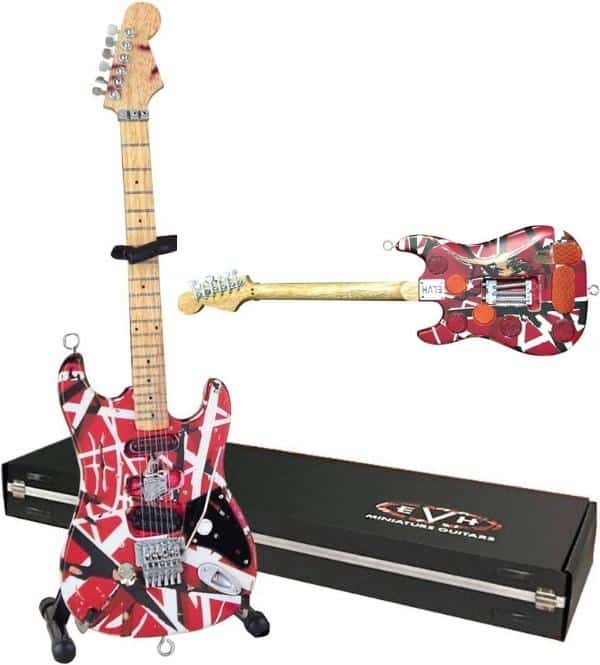
Click HERE To Check Price And Reviews On Amazon
Ibanez Prestige AZ2204N
This is one of my favorite Ibanez guitars because of how versatile it is, not to mention its playability and sound!
It features Seymour Duncan Fortuna pickups and a Dyna-MIX9 switching system that provides nine different pickup combinations! The switching system makes the humbucker sound great with the two single-coil pickups! You can simulate humbucking sounds by combining the two single-coil pickups.
The maple-roasted neck made by Ibanez’s S-Tech nitrogen-heating treatment and Gotoh T1702 tremolo provides excellent tuning stability! The stainless steel frets make note bending a breeze!
You get some much guitar for the money that it’s ridiculous (see the feature list below)!

Click HERE To Check Price And Reviews On Amazon
Features:
- 9″-12″ compound radius fingerboard
- Gotoh Magnum Lock machine heads with H.A.P. system
- AZ oval “C”-shaped roasted maple neck
- Oil-impregnated bone nut
- 22 ultra-durable stainless-steel frets with Prestige fret edges
- Seymour Duncan Fortuna pickups
- Ibanez dyna-MIX9 switching system
Charvel Pro-Mod San Dimas Style 1 HH Floyd Rose
Charvel is one of the premier names in metal guitars and the company that started it all! The San Dimas HH was one of the first compound radius neck models I ever played!
If you’re looking for a double-locking tremolo guitar that has all the classic sounds, you might want to give this one a closer look. It’ll take you back to the ’80s big hair and spandex days!

Click HERE To Check Price And Reviews On Amazon
Features:
- 12”-16” Compound radius fingerboard
- 22 jumbo frets
- Seymour Duncan humbuckers
- 6 pickup-switching combinations
- No-load tone pot
- Recessed Floyd Rose tremolo
Do Gibson Guitars Have A Compound Radius?
No, not typically. Gibson has traditionally used 10 and 12-inch radius necks on their electric and acoustic guitars.
Les Paul and SG guitars have a 12-inch “straight radius” fingerboard.
However, the Gibson Custom Shop has made a few compound radius “one-off” Les Paul guitars as special orders, equipt with Floyd Rose tremolos!
I have a Custom Shop Gibson ES-336 guitar with a compound radius neck and a custom-shaped headstock. It plays like a dream!
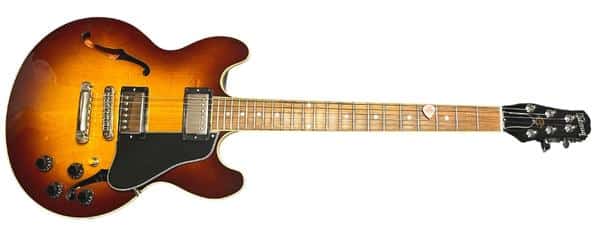
Frequently Asked Questions

Here are some of the questions I get asked about guitar necks.
If your question does not appear here, please put it in the comments, and I will get right back to you with an answer.
How Do I Pick A Guitar Neck?
The best way to choose a guitar neck is to play a variety of makes and models. This is because necks come in many shapes and fingerboard radius configurations. Getting a neck with the right “feel” can help give you the best playing experience.
Which Guitar Neck Radius Is easiest To Play?
A neck with a compound radius fingerboard is usually considered the easiest to play. In a straight radius (non-compound) neck, a 9.5-inch fingerboard provides the best compromise for playing chords and bending single notes.
Does Hanging A Guitar Damage The Neck?
No, hanging a guitar up correctly will not damage the neck. Be sure to use a finish-friendly hanger and be careful not to scratch or ding the guitar body’s finish against the wall when hanging the instrument or taking it down.
Should A Guitar Neck Be Bent?
A guitar neck should be as straight as possible so that all notes ring out clearly and without fret buzz or intonation problems. Many times, some degree of neck relief is required to have a guitar play and sound its best. Never attempt to adjust the neck unless you have experience with truss rods!
What Wood Is Best For Guitar Necks?
There is no one type of wood that is best for guitar necks. Maple and mahogany are commonly used because of their density and tone.
What Is The Most Comfortable Guitar Neck Shape?
Generally speaking, most electric guitar players seem to prefer a C-shaped neck. However, this will vary from player to player, depending on hand size, playing style, and musical genre.
Final Thoughts

I hope this article answered all your questions on do Strats have a compound radius neck! If I left anything out, ask me in the comments section, and I’ll get right back to you!
A neck with a compound radius fingerboard is maximally curved near the nut and progressively flattens out as it approaches the guitar’s body. This makes it more comfortable to play chords at the lower part of the neck and easier to bend notes in the upper ranges.
A compound radius allows a guitar’s action (string height) to be adjusted lower without intonation problems and string buzzing.
Some guitarists who have been playing traditional necks for many years could find it challenging to get used to a compound radius. This can typically take one week or less to adjust.
Fender does make some Strats with a compound radius, but the majority are made by companies that tend to specialize in heavy metal guitars.
Gibson electric guitars have a 12-inch fingerboard radius, with some exceptions. Their Custom Shop does make some compound radius models.
Here’s a video from Fender that talks about the American Ultra H-S-S Strat and other Ultra guitar models with a compound radius fingerboard. You can hear the sound of each one, so check it out!
Related Article ➡ 7.25 VS 9.5 Inch Fingerboard Radius – Which Is One Is Better?
Tell Me What You Think

Please leave a comment below if you enjoyed this article, have any questions about compound radius Strats, or want to give your point of view. I will be happy to help you.
- Do you have a Strat with a compound radius neck? Which one?
- What is your favorite neck radius? Why?
- After reading this article, are you considering getting a compound radius Strat?
- What else is on your mind?

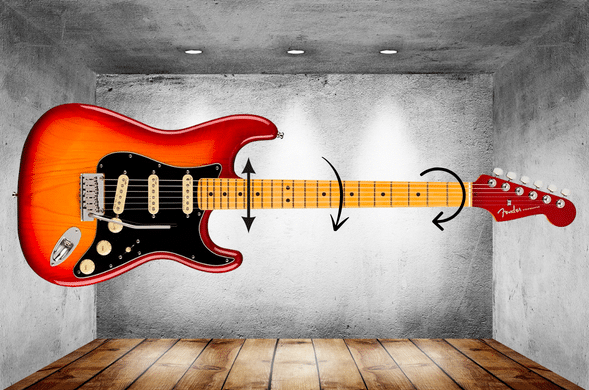

Thank you so much for this review over the strats on guitars. To be honest, fender is a great brand, but I really think Jackson is top tier in my opinion. Plus overall, Jackson has a better design for beginners, in my own opinion! I know that may cause a little contreversy ahhahah
Hey, Jessie
Thank You for your comments!
It’s all good! I totally agree that Jackson makes a great guitar. If you are a beginning player and want to get into Rock, Metal, or Blues, you really can’t go wrong with a Jackson guitar! 😎
They are guitars that can take you from newbie all the way to pro!
I love Jackson, Charvel, and Ibanez guitars.
Of course, Fender and Gibson are the “ol’ standards” by which others are often judged, and you can’t really go wrong in that direction either!
Take Care,
Frank 🎸
Excellent article; thank you for sharing Do Strats Have A Compound Radius. Very well structured, informative and very useful. I found it very interesting to learn about different guitars and strats. I am not an expert; more like a beginner. Thanks for sharing; lots of people will find it helpful; keep doing what you are doing—looking forward to learning more. Have a great day. Regards. Vlad
Hi, Vlad
I really appreciate your comments and compliments!
We all start as beginners the first time we pick up a guitar. I can still remember the sound of the first guitar I ever strummed. It was magical, even though I couldn’t play a thing!
If you buy another guitar and want an electric with a neck that can “do it all,” you should strongly consider a compound radius fingerboard.
Please visit my site again!
Take Care,
Frank
This is an article with useful information for guitar lovers. This musical instrument offers many satisfactions to those who manage to get to know them, to learn them, to use them properly. Choosing the right guitar makes the difference between pleasure and failure. Different people have different fingers, longer or shorter, thicker or thinner. The details about the different types of guitar necks are good.
Your page is pleasant and nicely arranged. The presented products are of superior quality.
All the best,
Daniel
Hi, Daniel
Thank You for your comments!
Very few, if any, “first guitars” will actually lead to a failure to learn, but starting with a nice instrument can undoubtedly help you progress nicely and will continue to perform adequately as you grow as a guitar player.
You don’t need to spend a lot of money on a guitar to get a good one. However, guitars with a compound radius fingerboard are typically on the higher end of the spectrum. Their playing advantages do justify the additional cost.
Take Care,
Frank 🎸